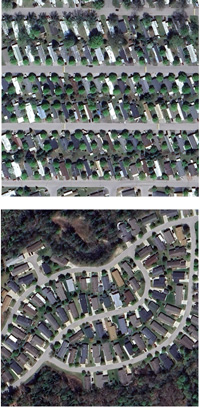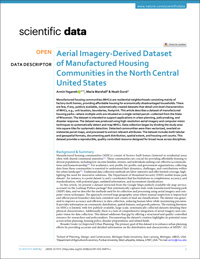 As a result of his North Central Regional Center for Rural Development (NCRCRD) Fellowship project, Armin Yeganeh, Assistant Professor of Construction Management at Michigan State University, recently published two open access resources that make significant contributions to advancing affordable housing research. Yeganeh first developed a low-cost, replicable AI data collection method that accurately maps manufactured housing communities (MHCs) and secondly, used this process to produce a new, open access database and GIS map resource of all MHCs in the North Central Region (NCR).
As a result of his North Central Regional Center for Rural Development (NCRCRD) Fellowship project, Armin Yeganeh, Assistant Professor of Construction Management at Michigan State University, recently published two open access resources that make significant contributions to advancing affordable housing research. Yeganeh first developed a low-cost, replicable AI data collection method that accurately maps manufactured housing communities (MHCs) and secondly, used this process to produce a new, open access database and GIS map resource of all MHCs in the North Central Region (NCR).
The NCRCRD Fellow Program offers awardees time and funding to pursue research and/or outreach projects that benefits the North Central Region. Yeganeh’s Fellow project sought to address the surprising lack of research around MHCs even though they are a vital source of affordable housing in both rural and urban areas of the United States. “The problem is that most existing data on MHCs is incomplete, inconsistent, or outdated, which makes it hard to track trends and understand community needs. I wanted to help fill that gap,” explained Yeganeh.

Aerial Imagery-Derived Dataset of Manufactured Housing Communities in the North Central United States published August 29, 2025 by Scientific Data.
To do that Yeganeh tapped into new advances in AI and geospatial technology to build a process that could detect and map the North Central Region’s MHCs quickly, accurately, and in a way that can be repeated over time and scaled from a single state to an entire region.
While AI and computer vision have been used in mapping before, no one has used them to spot MHCs at scale from aerial imagery. Also, this project used free imagery and parcel data that is open access or widely available. “What’s different here is that we’re using a fresh approach in a space that hasn’t seen much attention, and we’ve made it reproducible so others can build on it,” Yeganeh explained.
The open access dataset and GIS map resources generated by Yeganeh’s project can be useful to a wide audience of researchers, policymakers, nonprofits, for profits, housing advocates, industry, and service providers for use in studying housing affordability, land use change, and demographic patterns or to inform housing policy, zoning decisions, infrastructure planning, and disaster preparedness.
“Armin’s visionary work for his Fellow project is a considerable contribution to furthering affordable housing research in the North Central Region. Affordable housing is critical for our region’s rural communities to grow and thrive as it plays a key role in retention of workers and attraction of businesses,” related NCRCRD Associate Director, Michael Wilcox.
The following are the open access resources Yeganeh developed:
- Data collection methods: Armin Yeganeh, Maria Marshall, Purdue University/NCRCRD, and Noah Durst, Michigan State University, detail the methods used for collection and processing data using aerial imagery and computer vision techniques in the recently published article, “Aerial Imagery-Derived Dataset of Manufactured Housing Communities in the North Central United States,” published by Scientific Data. https://doi.org/10.1038/s41597-025-05875-z
Associated code scripts: https://github.com/arminyeganeh/mhc. The code scripts are licensed under the Creative Commons Zero v1.0 Universal License.
- MHC dataset and map resources (open access): Repository for Aerial Imagery-Derived Dataset of Manufactured Housing Communities in the North Central United States, https://doi.org/10.5281/zenodo.16459113. It is distributed under a Creative Commons Attribution 4.0 International License (CC BY 4.0).
# # #
The North Central Regional Center for Rural (NCRCRD) is one of four Regional Rural Development Centers in the United States. NCRCRD’s work links the research and educational outreach capacity of our region’s 34 land-grant universities with our region’s communities to help address a wide range of development issues unique to our 12-state region. For more information, please visit https://ncrcrd.org/.
NCRCRD receives core funds from the U. S. Department of Agriculture’s National Institute of Food and Agriculture (USDA NIFA) as well as from the North Central Regional Association of State Agricultural Experiment Station Directors (NCRA), North Central Cooperatives of Extension Association (NCCEA), and Purdue University, College of Agriculture.
